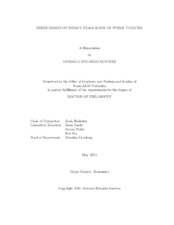| dc.description.abstract | This dissertation analyzes the impact of three public policies. Each essay attempts to identify the effects of a specific public policy using different methods. The first studies the effect of low-cost intervention on tax compliance. To overcome confounding factors, I use a regression discontinuity design that exploits a discrete increase in the probability of receiving a non-compliance notification. Results indicate that the notification significantly increases taxes paid by around $1,400, or 70 percent. These findings indicate that inexpensive tax compliance interventions can be used effectively by tax authorities in low-income countries.
The second essay studies data collected in a field experiment that provides information to households to promote conservation of electricity. Households received one of three different information interventions: (1) make a price notch salient, (2) make a social comparison, or (3) do both. Results corresponding to households with historical consumption above the notch indicate that the social comparison information reduces consumption by around 1%, and that the price salience information effect is not statistically significant. These findings imply that the social comparison treatment was more effective in promoting conservation. However, there is also suggestive evidence that the effect of the price salience treatment exists for households who were just above the notch, whereas the effect of the social comparison is significant for both households who were just above and well above the notch. The results suggest that similar interventions could be used in longer term projects to promote conservation and reduce the fiscal burden of electricity subsidies.
The last essay examines the effect of the Arizona Immigration Law of 2010 (SB 1070) on the noncitizen Hispanic state population. Results indicate that this bill produced a significant reduction in the proportion of Hispanic noncitizens living in Arizona estimated to be between 10% and 16%. However, this effect lasted less than one year, as the evidence suggests that it vanishes after a few months. The findings imply that the response of the undocumented population facing higher risk of deportation is to quickly move out. The findings also suggest that when that risk diminishes, the undocumented population tends to increase. | en |


